
Installation Information
Water Tower Specialists
Installing a co-location on a water tank requires additional skill sets and safety practices that are not encountered with 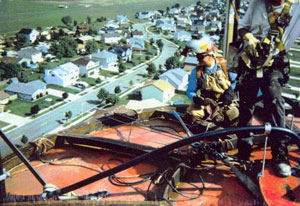 typical tower, monopole and rooftop installations, and carriers and tank owners should ensure that the selected contractor is proficient in all areas. typical tower, monopole and rooftop installations, and carriers and tank owners should ensure that the selected contractor is proficient in all areas.
Safety and health concerns first
In addition to working on a structure that does not provide the typical anchorage points that a technician is used to on a tower, water tower antenna installation projects will oftentimes require working in confined spaces within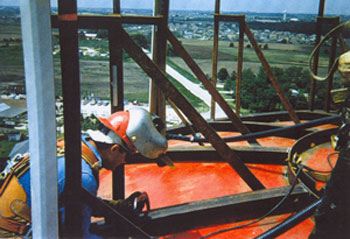 the interior of the tank. This requires specialized training as well as air packs, tripods and other associated safety equipment. (See Safety Training ). the interior of the tank. This requires specialized training as well as air packs, tripods and other associated safety equipment. (See Safety Training ).
Fall protection should be provided for installers. This may consist of a safety rail around the installation or anchor points on the tank roof where safety lines can be attached. The addition of auxiliary ladders or safety lines for access to new equipment should be considered, according to industry professionals. They say that cables should not be attached to ladders since it presents a safety hazard. Cable ladders or other commercially available cable support 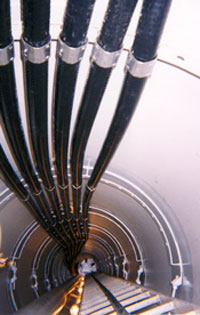 systems are available and should be installed separately on the tank. systems are available and should be installed separately on the tank.
A proposal to the American Water Works Association (AWWA) to add a section in the AWWA D100 standard on antennas and related communications equipment, calls out for manholes and other access ports to be unobstructed by cable routing. Where space is limited, the proposal suggests, such as in small diameter 36” access tubes in pedestal tanks, cables should be fitted to the access tube wall to maximize clearance.
It also recommends that safety precautions for RF exposure of personnel maintaining the site should be reviewed with the wireless carriers. According to the proposal, “precautions should be taken to prevent water contamination. Access to the tank interior water compartment should not be permitted.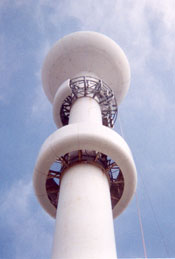 ” ”
It further states that the paint system should be checked for hazardous metals. When these metals are found in the paint system, the environment, potable water, and workers should be protected from contamination.
Cables placed along balconies and platforms should be routed so as not to obstruct access. Consideration should be given to providing auxiliary paint scaffold supports if the antenna installation renders the existing system unusable. Antenna cables should be raised off the tank surface to permit painting behind them.
General workmanship suggestions
Holes should not be cut in the supporting structure without making provisions to support the load acting on the cutout. It is recommended that penetrations 12” or larger in width/diameter be designed and installed by the original tank constructor.
Ideally, the tank should be empty when penetrations are cut into the 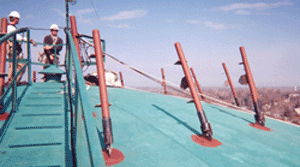 support structure, but this is oftentimes not feasible since water service must be maintained to the users. A compromise that is recommended in the proposal is that the water level should be drawn down at least 50% and stiffeners added to strengthen the support structure before openings larger than 3” in diameter are cut into the shell. The stiffeners act to prevent buckling of the shell and add area if the effective area of the penetration insert is not sufficient. When there are multiple penetrations, holes should be cut one at a time and insert necks welded into place before the next penetration hole is cut, according to the AWWA proposal. support structure, but this is oftentimes not feasible since water service must be maintained to the users. A compromise that is recommended in the proposal is that the water level should be drawn down at least 50% and stiffeners added to strengthen the support structure before openings larger than 3” in diameter are cut into the shell. The stiffeners act to prevent buckling of the shell and add area if the effective area of the penetration insert is not sufficient. When there are multiple penetrations, holes should be cut one at a time and insert necks welded into place before the next penetration hole is cut, according to the AWWA proposal.
Established tank welding issues
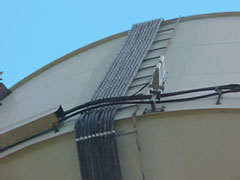 There are two universally accepted industry viewpoints. Welding recommendations can cause heated discussions, and high heat welding can cause blistering of the interior coating opposite the weld. If in the process of installing an antenna mounting system the contractor scorches the interior membrane, it can be a costly mishap. The best case scenario for repair is to wait until the tank is taken out of service for its annual inspection. However, the water tower owner may require the tank to be immediately emptied, cleaned and sanitized. To repair the blistering, an added expense of erecting a scaffold might be incurred to reach the damaged area. There are two universally accepted industry viewpoints. Welding recommendations can cause heated discussions, and high heat welding can cause blistering of the interior coating opposite the weld. If in the process of installing an antenna mounting system the contractor scorches the interior membrane, it can be a costly mishap. The best case scenario for repair is to wait until the tank is taken out of service for its annual inspection. However, the water tower owner may require the tank to be immediately emptied, cleaned and sanitized. To repair the blistering, an added expense of erecting a scaffold might be incurred to reach the damaged area.
Not many stuck on glue
Many owners and structural engineers will avoid epoxy attachments, believing that if there was a proven reliability that there would be more applications using glue. Temperature, pot life, cleanliness and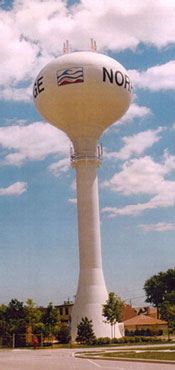 parallel tolerance of the surfaces all affect the strength of the connection and can cause the bond to fail. On a water tank, thermal stresses can be far worse than other structures since the exposed roof can reach 170 degrees F in the sun and ambient -25 degrees F in the winter. In addition, the thin roof will occasionally “oil can” from expansion with a resulting shape change of the surface. Epoxy applications should never be used on vertical surfaces. The attached framework can provide a false sense of security to a maintenance technician and the antenna support structure can easily fail when under minimal wind loading. parallel tolerance of the surfaces all affect the strength of the connection and can cause the bond to fail. On a water tank, thermal stresses can be far worse than other structures since the exposed roof can reach 170 degrees F in the sun and ambient -25 degrees F in the winter. In addition, the thin roof will occasionally “oil can” from expansion with a resulting shape change of the surface. Epoxy applications should never be used on vertical surfaces. The attached framework can provide a false sense of security to a maintenance technician and the antenna support structure can easily fail when under minimal wind loading.
Capacitive discharge stud welding
Except in cases where the tank is being painted inside and out, capacitive discharge stud welding is the only type of welding that many owners will allow on their tanks. Some engineers will require a test weld on an easily accessible (exterior as well as interior) location upon the tank similar in thickness to the intended installation area. An infrared thermometer can then be used to measure the interior surface coating’s temperature to ensure that it does not exceed the listed percentage of the rated temperature for coating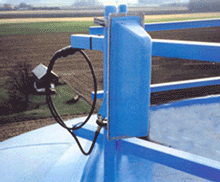 failure. failure.
Some engineers, however, have found that stud welding that is not done by experienced welders can easily blister the paint in the same manner as ordinary stick welding. In addition, they’ll require the stud welded side of the installation to be sealed. It is important to frequently check the welding equipment while in use.
Depending upon the experience of the installer, the stud may not develop adequate strength. A torque test as specified by the stud manufacturer is oftentimes required to ensure that the stud can develop its strength in tension.
Capacitor discharge stud welding is a semi-automatic arc welding process. The CDSW process operates on the principle of capacitor 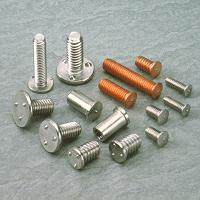 stored energy, which is instantaneously discharged by the equipment system through a special weld “timing” tip. Since the entire weld cycle is completed in several milliseconds, properly created welds can be made to steel without distortion, burn-through or discoloration. Capacitor discharge welding permits stud welding of dissimilar metals. A stud gun with spring pressure holds the stud against the intended work. Stored energy is discharged and the stud starts downward. The stud is then forced into molten metal which solidifies and the weld is completed in a split second. stored energy, which is instantaneously discharged by the equipment system through a special weld “timing” tip. Since the entire weld cycle is completed in several milliseconds, properly created welds can be made to steel without distortion, burn-through or discoloration. Capacitor discharge welding permits stud welding of dissimilar metals. A stud gun with spring pressure holds the stud against the intended work. Stored energy is discharged and the stud starts downward. The stud is then forced into molten metal which solidifies and the weld is completed in a split second.
Capacitor weld studs are manufactured in minimum lengths of 1/4” up to 2” as standard. Other lengths are available upon request. The studs do not undergo any loss of length after welding.
Arc stud welding is a welding process where the gun solenoid lifts the stud from 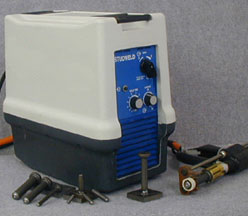 the metal surface and creates an arc which melts a flux-loaded end of the stud and its immediate area. A ceramic ferrule shields the arc, concentrates the heat and contains the molten metal in the weld zone. Simultaneously, the gun solenoid becomes de-energized and the spring tension forces the fastener into the molten pool, integrating it with the parent metal. The expendable ferrule is then broken away to expose a smooth and complete fillet at the stud base. the metal surface and creates an arc which melts a flux-loaded end of the stud and its immediate area. A ceramic ferrule shields the arc, concentrates the heat and contains the molten metal in the weld zone. Simultaneously, the gun solenoid becomes de-energized and the spring tension forces the fastener into the molten pool, integrating it with the parent metal. The expendable ferrule is then broken away to expose a smooth and complete fillet at the stud base.
Arc studs are reduced approximately 1/8-inch in length after welding for diameters up to 1/2” weld base diameter and approximately 3/16” for 5/8” weld base or larger.
Some prefer seal welding
A number of engineers will point out that stud welding is in conflict with Section 8.14 of the AWWA standard which requires attachments on external surfaces exposed to weathering to be seal welded to prevent moisture from being trapped between the shell and welded pad. They say it can effect rust streaking down the shell resulting in additional maintenance on the tank.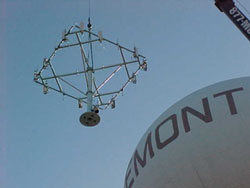
The AWWA proposal draft is requesting that all welding on a tank should be accordance with AWWA’s existing standard covered in D100 Section 8. In part, this requires all welds to the tank surface to be made with E7018 low hydrogen rods. It also requires that no welding should be done when the ambient temperature is below 32 degrees F unless the association’s cold weather welding requirements are followed.
Welding to the tank or access tube opposite the water level is typically not permitted. The water level should be drawn down to a level not less than two feet below the point of welding. Galvanized mounting components should not be welded directly to the tank surface. Galvanized surfaces should be ground free of galvanizing before welding.
Provide prior inspection
Contractors should carefully inspect the tank prior to any installation. Older tanks may be prone to hidden corrosion or damage that will only be noticed once the project is completed and a punch list is prepared.
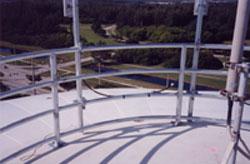 Coaxial cables should be arranged and located to allow protective wrapping during abrasive blasting and recoating during future maintenance. Neatly arranged cable offset from the tank will allow maintenance contractors to perform this work without having to remove the cable runs. Coaxial cables should be arranged and located to allow protective wrapping during abrasive blasting and recoating during future maintenance. Neatly arranged cable offset from the tank will allow maintenance contractors to perform this work without having to remove the cable runs.
If the new antennas are installed on the top of the tank, FAA obstruction lighting may need to be installed or raised to meet FAA guidelines. FAA height restrictions should be consulted.
High humidity can take toll on equipment
When electrical components are installed within the tank support pedestal, the effects of high humidity, moisture and condensation should be considered and the equipment adequately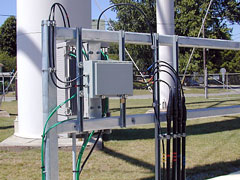 protected or waterproofed. protected or waterproofed.
When designing a co-location, try to exit the tank with your cables underground. This will help to protect your system when the tank requires repainting where scaffolding and a shroud will create problems when they have to accommodate a cable bridge.
Prior to adding any equipment to existing tanks, a structural review of added loads from the antenna installation should be considered.
 Installation pricing is always project-specific and will vary based upon the structure type and scope of work. We recommend that you contact our valued water tower co-location installation professionals to obtain additional information about their services, capabilities and experience. Installation pricing is always project-specific and will vary based upon the structure type and scope of work. We recommend that you contact our valued water tower co-location installation professionals to obtain additional information about their services, capabilities and experience.
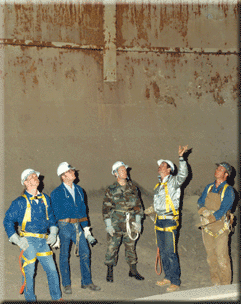
|